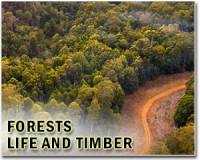| . |  |
. |
Woods Hole MA (SPX) May 27, 2011 One helpful action anyone can take in response to global warming is to plant trees and preserve forests. Trees and plants capture carbon dioxide during photosynthesis, thereby removing the most abundant greenhouse gas from the atmosphere and storing some of it in their woody tissue. Yet global warming may affect the capacity of trees to store carbon by altering forest nitrogen cycling, concludes a study led by Jerry Melillo of the Marine Biological Laboratory (MBL), published this week in Proceedings of the National Academy of Sciences. The paper summarizes the results of a 7-year study at Harvard Forest in central Massachusetts, in which a section of the forest (about one-quarter of an acre) was artificially warmed about 9oF above ambient, to simulate the amount of climate warming that might be observed by the end of the century without aggressive actions to control greenhouse gas emissions from fossil-fuel burning and deforestation. The study confirmed, as others have, that a warmer climate causes more rapid decomposition of the organic matter in soil, leading to an increase in carbon dioxide being released to the atmosphere. But the study also showed, for the first time in a field experiment, that warmer temperatures stimulate the gain of carbon stored in trees as woody tissue, partially offsetting the soil carbon loss to the atmosphere. The carbon gains in trees, the scientists found, is due to more nitrogen being made available to the trees with warmer soil. "Tree growth in many of the forests in the United States is limited by the lack of nitrogen," Melillo says. "We found that warming causes nitrogen compounds locked up in soil organic matter to be released as inorganic forms of nitrogen such as ammonium, a common form of nitrogen found in garden fertilizer. When trees take up this inorganic nitrogen, they grow faster and store more carbon." Melillo says that the biological processes that link soil warming, increased soil organic matter decay, increased nitrogen availability to trees, and increased tree growth will likely operate together in many temperate and boreal forests-forests found in North America, Europe, Eurasia and much of the developed world. Tree growth in tropical forests is often limited by factors other than nitrogen, so lessons from this new study are not widely relevant in the tropics. While Melillo thinks that the carbon-nitrogen interactions he is studying at Harvard Forest will help us to make predictions of carbon storage in forest over the coming decades, he adds that "the carbon balance of forest ecosystems in a changing climate will also depend on other factors that will change over the century, such as water availability, the effects of increased temperature on both plant photosynthesis and aboveground plant respiration, and the atmospheric concentration of carbon dioxide."
Share This Article With Planet Earth
Related Links Marine Biological Laboratory (MBL) Forestry News - Global and Local News, Science and Application
 Environmentalist husband, wife shot dead in Brazil
Environmentalist husband, wife shot dead in BrazilRio De Janeiro (AFP) May 25, 2011 A husband and wife team of environmentalists have been killed by gunmen in Brazil's northern Amazon state of Para, one of the most restive regions in the country due to land disputes, officials said Wednesday. Brazilian President, Dilma Rousseff ordered an immediate federal investigation to find those responsible for the double murder, in a wild region where owners of large estates are alleg ... read more |
|
| The content herein, unless otherwise known to be public domain, are Copyright 1995-2010 - SpaceDaily. AFP and UPI Wire Stories are copyright Agence France-Presse and United Press International. ESA Portal Reports are copyright European Space Agency. All NASA sourced material is public domain. Additional copyrights may apply in whole or part to other bona fide parties. Advertising does not imply endorsement,agreement or approval of any opinions, statements or information provided by SpaceDaily on any Web page published or hosted by SpaceDaily. Privacy Statement |